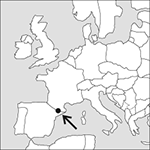
Capital:
Andorra la Vella
Area:
468 sq km (181 sq miles)
Population:
85,082 (2012 est)
Currency:
1 euro = 100 cents
Religions:
Roman Catholic
Ethnic Groups:
Spanish 43.0%; Andorran 33.0%; Portuguese 11.0%; French 7.0%
Languages:
Catalan (official); French; Spanish
International Organizations:
UN, OSCE, Council of Europe
A small co‐principality in the Pyrennes, between France and Spain.
Physical
Andorra has a landscape of valleys at around 900 m (3000 feet) which rise to peaks at 2900 m (9600 feet). The attractive mountain scenery is snow‐covered for several months of the year.
Economy
Tourism is the main industry, employing 37% of the labour‐force, and, combined with retail, and banking accounts for around three-quarters of the state’s GNP. The tax regime is limited—income tax was first introduced in 2013, under pressure from the EU.
History
According to tradition, Charlemagne granted independence to Andorra in 803 ad. Andorra came under the control of the Counts of Urgell and subsequently the Bishops of the diocese of Urgell. A dispute between the French and Spanish heirs of the Bishops and Counts in the late 13th century was resolved by making Andorra a co‐principality, jointly ruled by a French and a Spanish prince. In 1993 Andorra adopted a democratic constitution, which legalized political parties and reduced the powers of the co‐princes (who are now the President of France and the Spanish Bishop of Urgel), making them constitutional heads of state only. In that year, it joined the United Nations and in 2005 implemented a cooperation agreement with the EU. The 2011 parliamentary elections were won by the centre-right Democrats for Andorra with Antonio Martí as prime minister, defeating the Social Democratic Party.